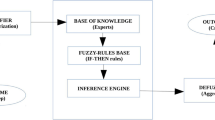Abstract
One of the major problems in the implementation of the precautionary principle in environmental cases is the estimation of the weight of evidence. In this paper we propose a formal method that determines the weight of evidence based on the specific parameters of a given case. The proposed method is based on an artificial intelligence approach called fuzzy logic, which is commonly used as an interface between logic and human perception, and often applied to computer-based complex decision making. We use one fuzzy expert system that provides a quantification of the estimated environmental damage, and a second fuzzy expert system that computes the weight of evidence in a given case. The proposed expert system can be easily defined and adjusted by regulators and environmental science and policy experts.







Similar content being viewed by others
References
Alaska oil Spill Commission (1990) Spill: The Wreck of Exxon Valdez 1
Anonymous Nitrates Directive (91/676/EEC) (1997) The Ythan catchment and estuary. Notification to Scothish Office, Stiriling, Scottish Environmental Protection Agency
Bronte CR, McKee CP, Holey EM, Toneys ML, Haver PE (2006) Relative survival of lake trout stocked at different sizes and quality in lake Michigan. J Great Lakes Res 32:386–394
Leatch v. National parks and wildlife Service and Shoalhaven City Council (1993) Case No. 10376.81 LGERA 270. Land and Environment Court of New South Wales, Sydney, Australia
EFTA Surveillance Authority v. Norway. (2001) Case E- 3/00, 2 C.M.I.R 47. European Free Trade Association Court, Luxemburg
Case C- 24/00, Commission v. France (2004) E.C.R.
Cameron J, Abouchar J (1991) The precautionary principle: a fundamental principle of law and policy for the protection of the global environment. Boston College Int Comp Law Rev 14:1–27
Cartagena Protocol on Biosafety. (1995) Article 1
EPA (1989) Exxon Valdez, http://www.epa.gov/oilspill/exxon.htm
Funabashi M, Maeda A, Morooka Y, Mori K (1995) Fuzzy and neural hybrid expert systems: synergetic AI. Intell Syst 10:32–40
Hunter D, Salzman J, Zaelke D (2001) International environmental law and policy, 2nd edn. Foundation Press
Hwang GJ (1999) A new environment for developing fuzzy expert systems. J Inform Sci Eng 15:53–69
Kandel M (1992) Fuzzy expert systems, CRC Press
MacGarvin M (2001) Science, precaution, facts and values. Reinterpreting the precautionary principle, pp 35–61. Cameron May Press
Maeda et al (1991) A fuzzy-based expert system building tool with self-tuning capability for membership functions. Proc World congress on expert systems, New York, pp 639–647
Mamdani EH, Assilian S (1975) An experiment in linguist synthesis with fuzzy logic controller. Int J Man-Mach Stud 7(1):1–13
Marchant G, Mossman K (2005) Arbitrary and capricious the precautionary principle in the European Union Courts, 11. International Policy Press
Masuoka R, Watanabe N, Kawamura A (1990) Neurofuzzy system-fuzzy inference using a structured neural network. Proc. Intl. Conf. Fuzzy Logic and Neural Networks. Yokohama, Japan, 1990, pp 173–177
McHughen A (2000) Pandora’s picnic basket—the potential and hazards of genetically modified foods. Oxford University Press, UK
Michigan Department of Natural Resources (2004) Public Rights on Michigan Waters, http://michigan.gov/documents/Water97e_142928_7.pdf
Miller H, Conko G (2000) Reply to the precautionary principle. Nat Biotechnol 18:697
Peterson CH, Rice SD, Short JW, Esler D, Bodkin JL, Ballachey BE, Irons DB (2003) Long-term ecosystem response to the Exxon Valdez oil spill. Science 302:2082–2086
Rosenbaum WA (2002) Environmental politics and policy, 5th edn. CQ Press, Washinton, DC, pp 249–254
Schneider M, Langholz G, Kandel A, Chew G (1996) Fuzzy expert system tools, Wiley InterScience
Shapira RA (2000) The application of fuzzy logic to the law of evidence. New Trends in Criminal Investigation and Evidence, 543. Leiden University Press
Shapira RA (1999) Fuzzy Measurement in the Mishnah and the Talmud. Artif Intell Law 7:273–288
Sandin P (1999) Dimensions of the precautionary principle. Hum Ecol Risk Assess 5:889–907
Siler W, Buckley JJ (2004) Fuzzy expert systems and fuzzy reasoning. Wiley InterScience
Soule E (2000) Assessing the precautionary principle. Public Aff Q 14:309–328
Spies RB, Rice SD, Wolfe DA, Wright BA (1996) The effect of the Exxon Valdez oil spill on the Alaskan coastal environment. Am Fish Soc Symp 18:1–16
Tinckner C (1996) State responsibility and the precautionary principle. In: Freestone D, Hey E (eds) The precautionary principle and international law, 53. Kluwer Law International, The Netherlands
United Nation Conference on Environment and Development (1992) Principle 15
Wiener JB, Rogers MD (2002) Comparing precaution in the United States and Europe. J Risk Res 5(4):317–349
Woolcock S (2002) The precautionary principle in the EU and its impact on international trade relations. CEPS Working Document No. 186:21
Zadeh L (1965) Fuzzy sets. Inform Control 8:338–353
Zadeh L (1983) The role of fuzzy logic in the management of uncertainty in expert systems. Fuzzy Sets Syst 11:199–227
Zadeh L (1988) Fuzzy logic. IEEE Comput 1:83–93
Zadeh L (2002) From computing with numbers to computing with words—from manipulation of measurments to manipulation of perception. Int J Appl Math 12:307–324
Zollweng E (2004) Great lakes lake sturgeon tributary database and Geographic information system demonstration, Proc. Of the Great Lakes Lake Sturgeon Coordination Meeting
Author information
Authors and Affiliations
Corresponding author
Rights and permissions
About this article
Cite this article
Shamir, M., Shamir, L. & Durfee, M.H. The application of fuzzy logic to the precautionary principle. Artif Intell Law 15, 411–427 (2007). https://doi.org/10.1007/s10506-007-9049-x
Received:
Accepted:
Published:
Issue Date:
DOI: https://doi.org/10.1007/s10506-007-9049-x




